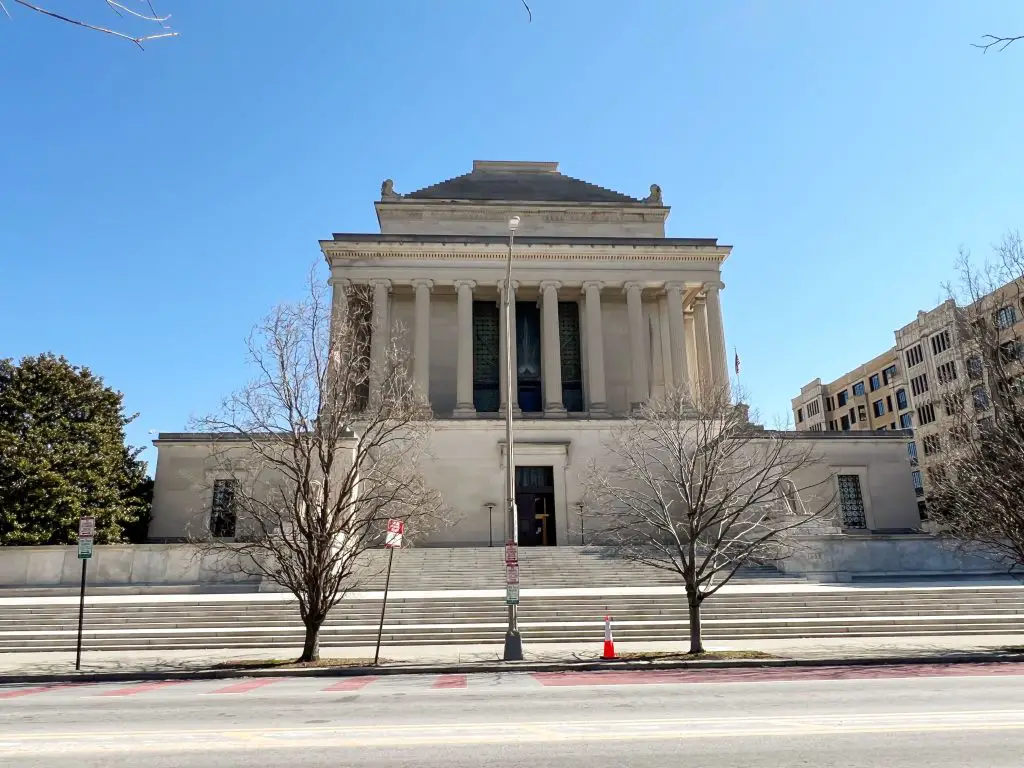Ever wondered about the hidden history behind Washington, D.C.’s iconic landmarks? Delve into the enigmatic world of Freemasonry with a tour of the capital’s key sites.
From the majestic George Washington Masonic National Memorial to the grandeur of the House of the Temple, this tour offers a captivating glimpse into the influence of Freemasonry on America’s capital city.
Join us as we unravel the mysteries behind the United States Capitol’s cornerstone ceremony and discover the Masonic symbolism adorning the Washington Monument.
Step inside Federal Lodge No. 1, the oldest Masonic lodge in D.C., and explore the enduring legacy of Freemasonry in shaping the nation’s history and culture.
Embark on a journey that reveals the intricate connections between Freemasonry and the architectural wonders of Washington, D.C. So, stay sharp.
Historical Context of Freemasonry in Washington, D.C.

Freemasonry, a fraternal organization with roots tracing back to the stonemason guilds of the Middle Ages, has played a significant role in the history of Washington, D.C.
The capital city itself is steeped in Masonic symbolism and influence, reflective of the prominence Freemasons had among America’s Founding Fathers.
Early Beginnings and Influence
Freemasonry in Washington, D.C. began shortly after the city’s establishment. The first lodge, Federal Lodge No. 15, was chartered in 1793, just three years after the capital was founded.
Freemasonry’s principles of liberty, equality, and fraternity resonated with many leaders of the new republic, and many influential figures in the early history of Washington, D.C. were Masons.
The Founding Fathers and Masonic Symbolism
Prominent among these Masonic Founding Fathers was George Washington, the nation’s first president and a devout Freemason.
Washington’s involvement with Freemasonry began long before he became president, and he was a Master of his lodge in Alexandria, Virginia.
His Masonic connection is symbolically preserved in various monuments and buildings throughout the city.
One of the most notable Masonic ceremonies was the laying of the cornerstone of the United States Capitol on September 18, 1793.
George Washington, dressed in full Masonic regalia, led the ceremony, which incorporated Masonic rituals and tools, symbolizing the Masons’ commitment to building the nation.
This event firmly established the Masonic influence in the city’s architectural and cultural foundation.
Architectural Contributions
The influence of Freemasonry is evident in the design and symbolism of Washington, D.C.’s architecture.
Many public buildings and monuments incorporate Masonic symbols, such as the square and compass, the all-seeing eye, and other esoteric imagery.
The city’s layout, designed by Pierre Charles L’Enfant, who was also a Mason, features streets and structures arranged in patterns that some interpret as containing Masonic symbols.
The House of the Temple
A significant landmark that epitomizes Freemasonry in Washington, D.C. is the House of the Temple. This grand edifice, completed in 1915, serves as the headquarters of the Scottish Rite of Freemasonry, Southern Jurisdiction.
The building itself is a testament to Masonic architecture, inspired by the Mausoleum at Halicarnassus and featuring numerous Masonic symbols and references. It houses an extensive library and museum dedicated to the history and principles of Freemasonry.
Masonic Lodges and Social Influence
Washington, D.C. has been home to numerous Masonic lodges over the centuries. These lodges have served not only as places of fellowship and ritual but also as centers for civic and philanthropic activities.
Freemasons have historically engaged in various charitable endeavors, supporting education, healthcare, and community services, reflecting their commitment to social betterment.
Political and Cultural Impact
Freemasonry’s impact extends beyond architecture and philanthropy to the political and cultural realms. Many political leaders, including several U.S. Presidents, have been Freemasons, and their membership often influenced their values and leadership styles.
The principles of Freemasonry, emphasizing moral integrity, intellectual enlightenment, and civic responsibility, have paralleled the democratic ideals of the United States.
Contemporary Freemasonry in D.C.
Today, Freemasonry continues to be an active and influential presence in Washington, D.C. Modern lodges uphold the traditions of their predecessors while also adapting to contemporary societal needs.
They remain engaged in charitable activities and community service, maintaining the legacy of their forebears.
The historical context of Freemasonry in Washington, D.C. is rich and multifaceted.
From its early beginnings with the city’s founding to its ongoing contributions to architecture, politics, and society, Freemasonry has left an indelible mark on the capital.
Its principles and symbols are interwoven with the very fabric of the city, reflecting the enduring influence of this venerable fraternity.
Planning A Freemason Tour Washington DC

Exploring the influence of Freemasonry in Washington, D.C. offers a unique perspective on the city’s history and architecture.
A Freemason-themed tour can be both educational and intriguing, highlighting the significant Masonic landmarks and symbols embedded in the fabric of the nation’s capital. Here are some key stops and points of interest to consider:
George Washington Masonic National Memorial
Located in Alexandria, Virginia, just a short drive from downtown D.C., this grand memorial honors George Washington, the most famous American Freemason.
The museum and observation deck offer insights into Washington’s Masonic involvement and provide panoramic views of the capital region.
The United States Capitol Cornerstone
A visit to the United States Capitol is essential. On September 18, 1793, George Washington laid the cornerstone of the Capitol in a Masonic ceremony.
While the exact location of the cornerstone remains a mystery, the Capitol Visitor Center provides detailed information on this historic event and the Masonic symbols used during the ceremony.
The House of the Temple
The House of the Temple, located at 1733 16th Street NW, is the headquarters of the Scottish Rite of Freemasonry, Southern Jurisdiction.
Designed by John Russell Pope, this impressive building, inspired by the Mausoleum at Halicarnassus, is rich in Masonic symbolism.
The library and museum within offer extensive exhibits on Masonic history, artifacts, and architecture.
Lafayette Square and the White House
Lafayette Square, directly north of the White House, is named after Marquis de Lafayette, a Freemason and key figure in the American Revolution.
This area, along with the White House, is steeped in Masonic history and symbolism, with several statues and buildings linked to Freemasonry.
Albert Pike Statue
Although it was removed in 2020, the site of the Albert Pike Statue at Judiciary Square remains a point of interest. Pike, a prominent Freemason and Confederate general, authored several important Masonic texts.
The statue’s removal sparked discussions on historical memory and the role of Freemasonry in American history.
Freemason Lodges
Washington, D.C. is home to numerous Masonic lodges, each with its own unique history. Notable lodges include Federal Lodge No. 1 and Naval Lodge No. 4.
Many lodges offer tours or have public events where visitors can learn about Masonic rituals, traditions, and their contributions to society.
National Museum of American History
While not exclusively Masonic, the Smithsonian’s National Museum of American History houses several artifacts related to Freemasonry, including George Washington’s Masonic apron and other regalia.
These exhibits provide a broader context of how Freemasonry intersected with American history and culture.
Symbolism in the City Layout
Pierre Charles L’Enfant, a Freemason, designed the layout of Washington, D.C. The city’s design is believed to incorporate Masonic symbolism, with streets and buildings arranged in patterns that reflect Masonic principles.
A guided tour focusing on the city’s layout can reveal these hidden symbols and their meanings.
A Freemason tour in Washington, D.C. offers a fascinating journey through history, architecture, and symbolism.
From grand memorials to subtle city designs, the influence of Freemasonry is deeply woven into the capital’s fabric, providing a unique lens through which to explore America’s heritage.
Practical Tips for Freemason Tour Washington DC

Exploring the Masonic heritage of Washington, D.C. can be a rewarding and enlightening experience. To make the most of your Freemason-themed tour, consider these tips to help you navigate the city’s rich Masonic history and symbolism effectively.
1. Plan Ahead and Research
Before embarking on your tour, spend some time researching the key Masonic sites and their historical significance.
Understanding the background of places like the George Washington Masonic National Memorial, the House of the Temple, and the Capitol cornerstone ceremony will enhance your appreciation of these landmarks.
Many Masonic sites offer guided tours that provide in-depth information, so check their websites for tour schedules and any special events.
2. Create a Flexible Itinerary
While it’s important to have a plan, keep your itinerary flexible to allow for unexpected discoveries and additional time at particularly interesting sites.
Start with the must-see locations, such as the George Washington Masonic National Memorial and the House of the Temple, and then explore other sites like Federal Lodge No. 1 and the National Museum of American History. Allocate time for both guided tours and independent exploration.
3. Understand the Symbolism
Familiarize yourself with common Masonic symbols and their meanings. Symbols such as the square and compass, the all-seeing eye, and the beehive are prevalent in Masonic architecture and artifacts.
Recognizing these symbols can deepen your understanding of the Masonic influence on Washington, D.C.’s design and structures. Resources like books or online articles on Masonic symbolism can be helpful.
4. Engage with Local Masons
Reach out to local Masonic lodges or organizations before your visit. Many Masonic bodies are welcoming to visitors and may offer tours, lectures, or even the opportunity to attend a meeting.
Engaging with local Masons can provide unique insights and enhance your experience. Federal Lodge No. 1, for instance, has a long history and remains active, making it a valuable stop on your tour.
5. Utilize Public Transportation
Washington, D.C. has an extensive and efficient public transportation system, including the Metro, buses, and bike-sharing options.
Utilizing public transportation can help you navigate the city more easily and avoid the hassle of parking. Many key Masonic sites are conveniently located near Metro stations, making it simple to move between locations.
6. Document Your Journey
Bring a camera or smartphone to document your tour. Take photos of Masonic symbols, architectural details, and significant landmarks.
Keeping a journal or notes about your experiences and what you learn at each site can also be valuable. These records will not only help you remember the details of your trip but can also be shared with fellow Masons or enthusiasts.
7. Respect the Sites and Rituals
Many Masonic sites are working lodges or temples with active members and ongoing rituals. Be respectful of these spaces and the people who use them.
Follow any guidelines provided by tour guides or posted at the sites, and be mindful of any areas that are off-limits to non-members.
Showing respect for the traditions and practices of Freemasonry will ensure a positive experience for both you and the local Masonic community.
8. Combine Historical and Modern Perspectives
While exploring historical sites, consider how modern Freemasonry continues to impact society. Visiting contemporary lodges and speaking with current members can provide a balanced view of Freemasonry’s evolving role.
Understanding both the historical context and current practices of Freemasonry will give you a more comprehensive perspective on its significance in Washington, D.C.
A Freemason tour in Washington, D.C. is an enriching journey through history, architecture, and symbolism.
By planning ahead, engaging with local Masons, understanding Masonic symbols, and being respectful and flexible, you can create a memorable and insightful tour.
This experience not only highlights the profound influence of Freemasonry on the nation’s capital but also connects you with a tradition that continues to thrive today.
Wrapping Up
Exploring Washington, D.C. through the lens of Freemasonry unveils a unique and profound aspect of the city’s history.
From the George Washington Masonic National Memorial to the House of the Temple and the historic Federal Lodge No. 1, each site offers deep insights into the influence of Freemasonry on the nation’s capital.
Understanding the Masonic connections behind iconic landmarks like the Capitol and the Washington Monument enriches your appreciation of their historical significance.
This tour not only highlights the architectural and symbolic contributions of Freemasonry but also connects you with a tradition that continues to shape the fabric of American society.




Scott Jung